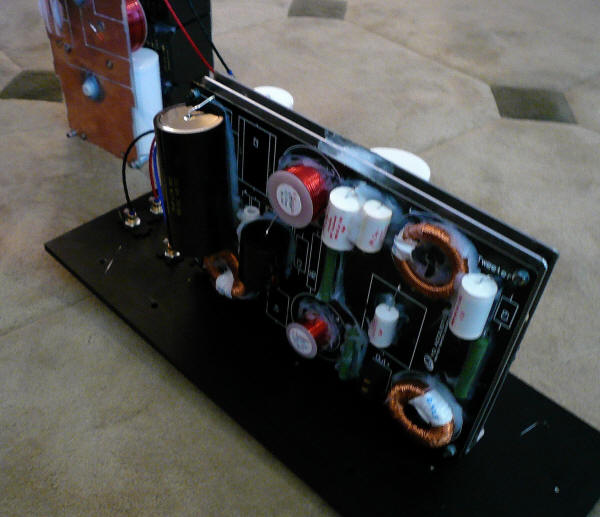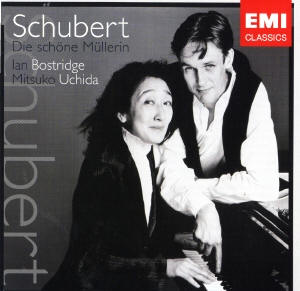|
You are reading the older HTML site
Positive Feedback
ISSUE
57
YG
Anat Signature Mod - The Crossover Perfected
Here's What You Get: Function The YG Anat III Signature mod that's just been released is a DualCoherent™ designed crossover upgrade for the mid/woofers. Its primary function is to reduce midrange distortion at all volumes. Secondarily, it increases the power handling of the Main Module (the mid/woofers plus the tweeter). In the standard Anat speaker, the BilletCore™ 6" mid/woofs have a low-pass filter in the crossover to cut off frequencies above 1,750Hz, where the tweeter kicks in. Their low end is allowed to roll off naturally at around 43Hz.
Main Module crossover.
Main Module crossover, reverse side. Here's the standard crossover in the Main Module. The Signature mod is an addition to this; not a replacement.
Signature mod addition. What it does is reassign the frequencies below 65Hz. The mid/woofs get a high-pass filter at that frequency. As for the subwoofers, there are no hardware changes, but their cutoff frequency is raised to that point. (Several controls get adjusted, all of which are explained in the full manual supplied.) Here's What You Get: Parts The Signature mod costs $8000, for which you get two inductors; six very large, black capacitors; and two extremely large white caps per side. All are custom manufactured by Mundorf.
These are the parts you get.
Installation Installation requires two people and takes a little under an hour. The new parts come on a beautifully constructed aluminum cage, which slips nicely into a vacant interior space next to the standard crossover. No soldering is required; the wires to be moved have spade terminations. Note the wide copper traces on the printed circuit boards.
Here's the rear of the Main Module.
Inside the Main Module with only the Signature Mod in place.
Putting back the standard crossover. Burn-In Even though it is a high-pass filter, the signal—all of it—passes through the new parts. Unfortunately, this mandates another round of burn-in, about as lengthy as when the speakers were new. At 20 hours the sound is anemic. At 50 hours, I still didn't want to turn on the system. But at 100 hours… Here's What You Get: Sound …It all comes together. And it is shockingly good. The effect is not the minor improvement that you'd expect from a crossover tweak. It is a fundamental, even radical, change. The Designers Vision Fulfilled The standard Anat already exhibited incredible, pace-setting resolving power. But it wasn't perfect. What the Signature mod does is fulfill the designer's vision. By allowing the mid/woofs to roll off naturally at their low end, a degree of warmth was generated. Another byproduct was the introduction of obscurity. Together, these artifacts act like a cloud cover. The Signature mod damps and controls that region, and consequently, the speaker will have somewhat less warmth and bloom. But what you get in return is a prescription for 20/20 vision.
Let's listen to Ian Bostridge accompanied by Mitsuko Uchida performing Schubert's Die Schöne Müllerin (EMI 5 57827 2) with the mod in place. There are new micro-details available, especially in the textural domain. There's continual morphing in the dynamic realm—and this is big. Playback is incredibly lively. Every little squiggle and syllable of Ian's vocal production lifts off with a distinctly different dynamic jump. Together these things stamp the performance with a fidelity to live. Somehow, controlling the mid-woofs' bottom range has impact all the way up into the treble. This is audible as complete openness and visibility throughout. It's not enough to say it has stunning coherency. Ian sounds like he's present in the room with you. Audible Characteristics As noted, there is less bloom. It may also sound thinner. The mod was put in place while I was reviewing the Tenor 175S hybrid amp and there is definitely less warmth, less romance now (albeit less coloration and more truth to the source). To an extent, these can be addressed by boosting the sub's volume and cutoff frequency. Some people felt the standard Anat was a little dark. Any reservations along those lines can be dismissed with the Signature mod; treble extension is excellent and completely open. Conflicting Dogma This hobby is plain confusing with its conflicting dogmas. I just read a speaker review in TAS in which the reviewer asked the question, "What is the best crossover?" By way of answer, he reiterated the audio maxim, "No crossover." Next best would be a first-order crossover, the simplest one you can make. And he went on to extol the simplicity of the one under review. Simplicity is intellectually satisfying. But did anybody ever put it to the test? YG responded eloquently to this in one of their advertisements entitled, "Phase-coherent in reality, not 1st-order in theory." "…reality and theory are not the same. In reality, when taking into account the drivers and cabinet, no design offers zero absolute phase. Furthermore, when dealing with real (i.e. non-ideal) designs, the wide overlap of a 1st-order crossover forces drivers to operate outside their optimal band, where performance is highly compromised. YG Acoustics takes a different approach: rather than traditional crossovers, it employs proprietary circuitry, designed using software developed entirely in-house. The resulting absolute phase matches that of the finest 1st-order designs, but with the added advantage that drivers only operate within their optimal band. Most importantly—relative phase is near-zero, i.e. all drivers radiate as one integral unit." Without arguing about theories, I'll simply recommend you listen to each type. Then you can decide—let the speakers speak for themselves.
|


